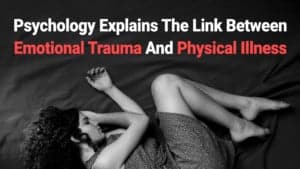Have you ever had a nightmare? Then you’re probably familiar with that sense of relief when you wake up and realize that the harrowing episode was all a figment of your imagination.
It sure felt real though.
Many of us are familiar with this feeling. According to the American Academy of Sleep Medicine (AASM), up to 85 percent of all adults have occasional nightmares. According to many of these experts, the occasional bad dream may be healthy.
It is important to note the word intermittent.
That’s because, unfortunately, there are conditions wherein a person is subject to “the repeated occurrence of frightening dreams that lead to awakenings from sleep.” This includes a relatively common one known as nightmare disorder.
Some Background Info About Nightmares
Here are a couple of important points to keep in mind going forward:
- We will discuss how nightmares may be healthy for the psyche. However, most psychologists and sleep experts concur that nightmares stemming from an underlying psychological disorder probably don’t carry the same benefits. For example, nightmares due to post-traumatic stress disorder (PTSD) and major depressive disorder (MDD).
- Some studies also show a correlation between nightmare frequency and suicidal ideation. Per the study cited, individuals who attempted (but did not commit) suicide were more likely to complain of recurrent nightmares than the rest of the population.
In short, those with nightmares and mental health problems should discuss them with a psychologist or someone of similar expertise.
Such disclosures aside, nightmares may indeed be healthy.
Let’s discuss the science of nightmares to gain a rudimentary understanding of what’s going on under the hood.
The Neuroscience of Nightmares
Dreams are a product of the brain’s default mode network (DFN). The DFN are areas of the brain that tend to remain active even during periods of relative quiet. One such time is during REM sleep, which is about one-fifth of our total sleep time.
REM periods typically involve the consolidation of memories, which often cause vivid imagery to be projected from the subconscious. As such, if such images are indeed unpleasant, the individual may experience a bad dream.
As REM intervals become longer, the chances of having a nightmare rise.
Certain medical conditions called parasomnias are sometimes mistaken for nightmare disorders. These include:
Night terrors: Episodes of disorientation following slow-wave sleep and produce severe symptoms such as kicking, screaming, or thrashing. Sometimes, the person experiencing the night terror may unconsciously bolt from the bed. The confusion that characterizes night terrors may leave the person unable to remember the event, which is often not the case for someone who experiences a nightmare. Night terror will usually occur within three hours of sleep commencement.
REM sleep disorder: Normally, the body is immobile while we sleep – a state called sleep paralysis – to prevent us from acting out our dreams. People who suffer from REM sleep disorder, however, may become mobile due to irregular wave production within the brain. That’s because the brain might deactivate the brain circuitry responsible for sleep paralysis. REM sleep disorder is most common among men of middle age.
A Note about the DFN
Although this may be off-topic, it is worth briefly discussing the potential problems of an overactive default mode network. Once again, the DFN is most active when the brain is at rest or otherwise uninvolved in a cognitive task.
Research implicates DFN activity in major depressive disorder (MDD) and feelings of anxiety. Moreover, Harvard Researchers have already found that DFN activity is directly linked to “automatic pilot” thinking and behaviors, which are, in turn, significant sources of unhappiness and life dissatisfaction.
The DFN also engages if someone thinks about themselves, remembers the past, or as they set future goals.
It seems fair to conclude that making lifestyle adjustments or training the brain to spend less time in rumination – an explicitly DFN activity – may be conducive to reducing or eliminating unhealthy nightmare episodes. We’ll talk more about how to do precisely that in the ‘Final Thoughts’ section.
Risk factors that might cause nightmares
Here are some risk factors that may be associated with more nightmares:
– A concurrent sleep disorder (e.g., insomnia, sleep apnea, etc.)
– An untreated medical condition
– Certain prescription medications (e.g., antidepressants, beta-blockers, dementia meds, and perhaps some others.)
– Mental health disorders, such as anxiety, depression, or PTSD.
– Substance abuse (e.g., alcoholism, drug addiction)
Statistics and Trends
Here are some statistics and trends about nightmares that you may find both interesting and relevant:
– For 3 to 7 percent of the U.S. population, nightmares may be considered a “problem.” (By “problem,” these experts are likely referring to disturbed sleep stemming from nightmares.)
– Nightmares are more common between the ages of 3 and 6. (Nightmares peak in number and subsequently decline around age 10.)
– 1 in 20 people experience at least one nightmare every week.
– About 75 percent of those PTSD and 50 percent with personality disorder experience regular nightmares.
How Nightmares May Be Healthy
“…if you have garden variety nightmares occasionally, that’s a really good opportunity to understand … more about unconscious fears and anxieties that may be cropping up.”
~ Deidre Barrett, Ph.D., assistant professor of psychology at Harvard University and author of Trauma and Dreams (Source)
In a two-study article published in the journal Human Brain Mapping, researchers sought out to determine the validity of an emerging psychological theory; specifically, that nightmares enable individuals to resolve emotional distress while stabilizing volatile emotions during wakefulness.
To put this theory to the test, the research team looked at and analyzed the data of two studies.

Study #1
In the first study, the research team used the “serial awakening” method to inquire whether they had experienced any fear in any dream state. That involved waking subjects repeatedly following brief periods of sleep.
The primary objective of the first study was to reaffirm that the brain regions associated with fear in dreams also correlate with the processing of undesirable emotions during periods of wakefulness.
Study #2
In the second study, 89 participants reported their level of emotional arousal during waking hours. Functional magnetic resonance imaging (fMRI) technology pinpointed the areas of the brain associated with fearfulness during the waking state.
The second study’s primary objective was to compare individuals’ emotional regulation levels during waking hours to fear levels experienced during sleep.
Study Results
In the first study, 12 of 18 participants were tested for “[brain imaging] analysis of fear versus no fear conditions” during non-REM (NRM) sleep, while the remaining eight subjects were tested for the same conditions during REM sleep.
The researchers affirmed that fear in dreams primarily involves two brain regions. They’re the insula and the midcingulate cortex.
The second study found that “those reporting [a] higher incidence of fear” while dreaming demonstrated both reduced emotional arousal during wakefulness and decreased brain activity in the insula and midcingulate cortex “in response to fear-eliciting stimuli” during waking hours.
In short, nightmares may strengthen our emotional resilience and allow us to untangle and resolve issues of the psyche that usually remain below the surface.
 Final Thoughts: Are Nightmares Worth It? (Answer: It depends.)
Final Thoughts: Are Nightmares Worth It? (Answer: It depends.)
Now for some straight talk followed by some reflection. Ready?
Straight talk first: nightmares suck, especially when they interfere with getting the restful sleep that we all desperately need.
Now for some rational reflection.
Are these researchers are onto something, and nightmares really do untangle deeply-hidden psychological skeletons? Or, is it worth it to suffer through the temporary experience?
It seems the best answer is a solid “Maybe.”
It’s probably worth it for individuals who are regularly dealing with high stress and irritability. The reason is that an occasional nightmare may both serve as a release for the underlying cause and strengthen their emotional resilience when faced with a similar situation in the future. So, the payoff is potentially great.
But individuals with deep-seated mental health issues or trauma do not reap these benefits. As such, we’re using the closing words of the article to reemphasize the following point:
Nightmares stemming from mental health disorders, including trauma, require assistance from a trained professional.














 Community
Community

